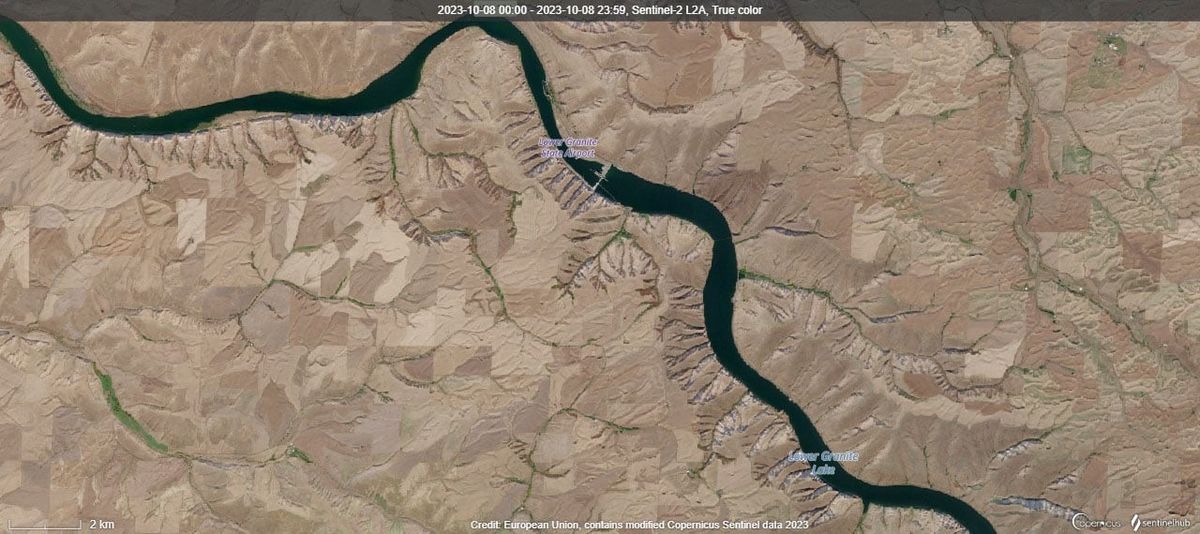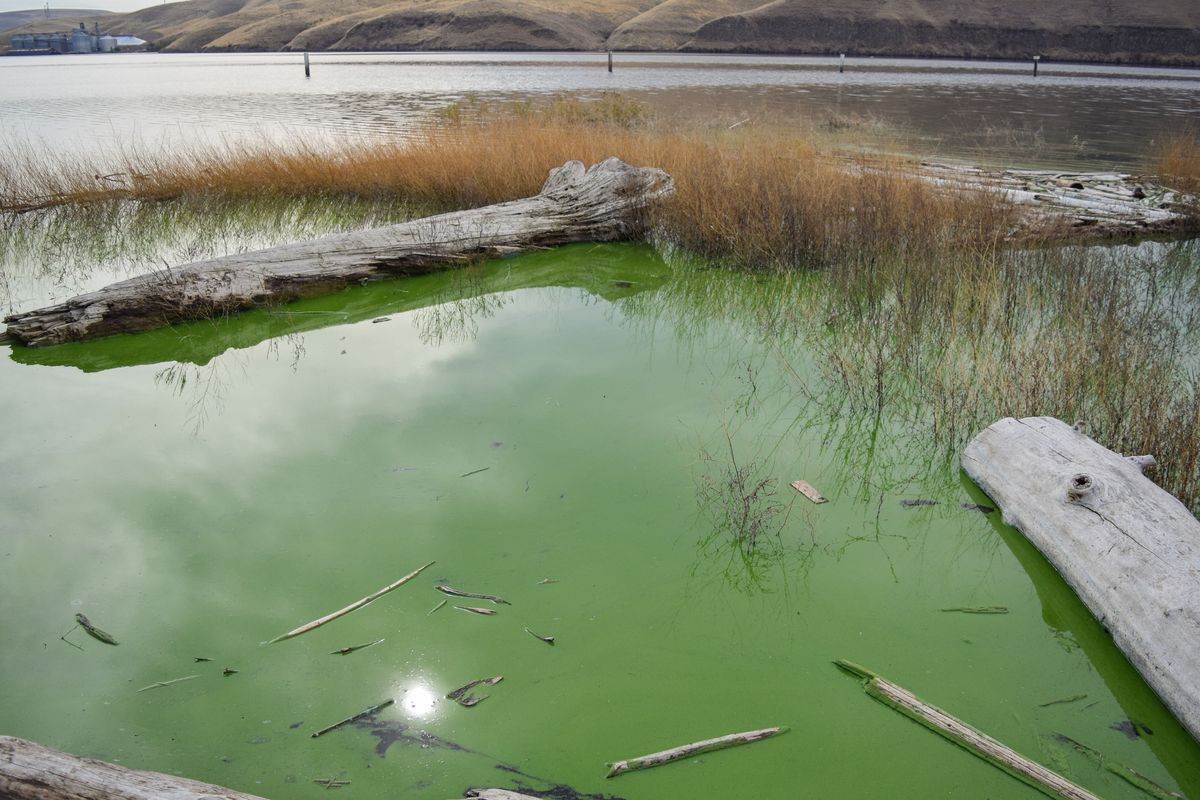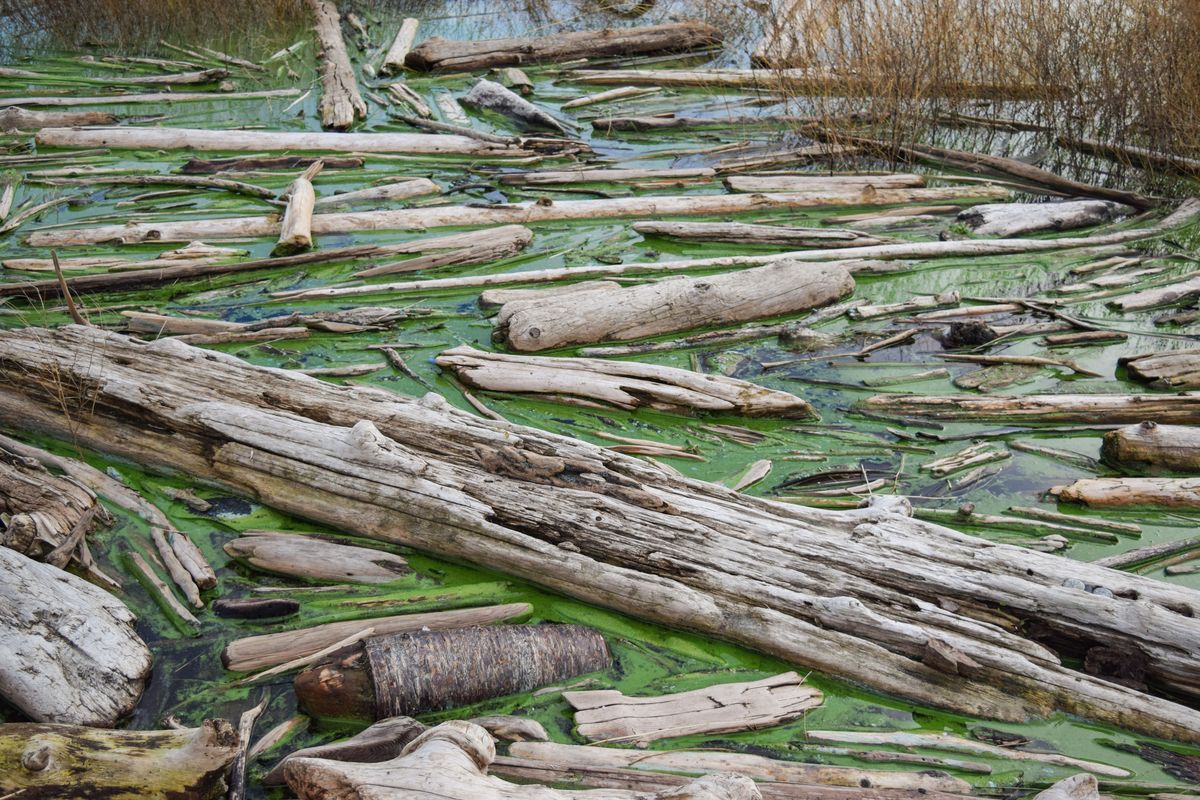‘Unusually large’ toxic algal bloom covers 30-mile stretch of the Lower Snake River
Toxic algal bloom at Central Ferry on the Snake River. (Courtesy Whitman County Public Health)
A frothy, green layer of muck recently coated a mileslong stretch of water on the Lower Snake River in southeast Washington, and scientists have warned people and their pets to stay away.
The Whitman County Health Department issued an alert Oct. 6 that a blue-green algal bloom released toxins into the water between Wawawai Landing and Central Ferry State Park, making a roughly 30-mile stretch of the river temporarily hazardous for humans, pets and livestock.
Satellite images show the west-flowing river changed color from blue to a deep green over a short span of days. County workers posted signs along the contaminated stretch of river alerting the public to stay away from popular recreation spots for swimming, fishing and boating. The safety alert remained in effect as of Tuesday night.
Algal blooms typically last days to weeks before dying off naturally and disappearing.
The bloom on the Lower Snake appears to have started dying off, Whitman County Public Health Director Chris Skidmore said. But until the water tests safe for two consecutive weeks in a row, it is considered dangerous under state health guidelines.
“When I saw it near Wawawai, it literally was the consistency of a very thick milkshake,” Skidmore said. “Really big buildup. It’s pretty gross.”
The county health department has been monitoring the algal bloom since Oct. 2, when a water sample tested above the state health guidelines for microcystin. Microcystin is a liver toxin and can be harmful to touch and ingest for humans, pets and livestock. Fish and bird mortalities have also been reported in lakes and rivers with persistent cyanobacteria blooms.
Algal blooms are becoming increasingly common in bodies of water. There are many types of blooms, and they’re not always toxic. Sunny days combined with high nitrogen, phosphorus and potassium levels in the water are the recipe for a bloom.
An algal bloom showed up on the Lower Snake last year, but the county health district did not put up warning signs or send out an alert because the bloom reportedly did not emit toxins.
Maddy Lucas is a chemist who collects water samples for the county health department once a week. The most recent test samples – collected Friday – indicated the Wawawai and Central Ferry locations still contained harmful toxins.
Algal blooms are becoming more frequent across the state, Lucas said. Scientists from the U.S. Environmental Protection Agency have reportedly been doing algal bloom research on the Columbia River this year.
The algal bloom on the Lower Snake is the most extreme bloom Lucas has seen in that body of water.
“This is a pretty sizable bloom to see on a river,” Lucas said. “And it is thick. At some points, it stretched across the entire river, shore to shore.”
The state water safety threshold is eight parts per million for blue-green algae. If a health department collects a sample that tests above this value, it issues a warning for the body of water. Water collected Friday from Wawawai Landing tested 17 times more potent than the state’s safety threshold for cyanobacteria at 139 parts per million.
Regular testing is crucial, Lucas said, because it’s impossible to tell if an algal bloom is toxic just by looking at it.
It’s hard for scientists to predict when a bloom will happen, said Colleen Keltz, a spokesperson for the Washington Department of Ecology. But years where there are warm, dry springs can be a setup for algal blooms.
Blooms are more common in stagnant bodies of water, such as lakes. In rivers, blooms happen more near dams or natural blockades that disrupt the current.
Alex Fremier, an environmental science professor at Washington State University, said the bloom on the Lower Snake is “unusually large” for a river.
“The Snake River at that section has a bunch of dams on it,” Fremier said. “At this time of year, it functions more as a reservoir than a river.”
Algal blooms can harm water ecosystems when they die, because decomposing blooms absorb oxygen from the water. Low dissolved oxygen levels in water can kill fish and other river-dwelling animals and plants.
Whether a bloom will harm wildlife depends on a lot of factors. Cooling temperatures and rain brought by fall will decrease chances that the Lower Snake bloom will damage the ecosystem there, Fremier said.
Conditions for algal blooms are primed by certain human land use practices, as well as climate change. Fremier said nitrogen and phosphorus fertilizers that run off into rivers and dams that block the current are big contributors. Globally, algal blooms are increasing in a warming climate, he said. Warming temperatures and dryer conditions are a recipe for algal blooms, he said, and seeing blooms in rivers more often could be part of the “new normal” in a warming climate.
“Blooms are going to happen, and they’re going to happen with increased frequency,” Fremier said. “That’s the bigger concern. We have to have the systems in place to protect ourselves and protect the public.”
Dammed waters and blooms are “certainly” connected, Fremier said.
Until the health department determines the water is safe again, people are urged to take the following precautions near the Snake River between Wawawai Landing and Central Ferry State Park:
•Do not drink, swim, wade, use personal watercraft, water ski, fish or boat in the water.
•Wash skin and clothing with soap and water if you have contact with the river’s water.
•Keep pets away from the area. Pets and livestock should have a different source of water while the safety warning is in place.
•Do not cook or clean dishes with water in the river. Boiling the water will not eliminate the toxins.



